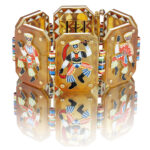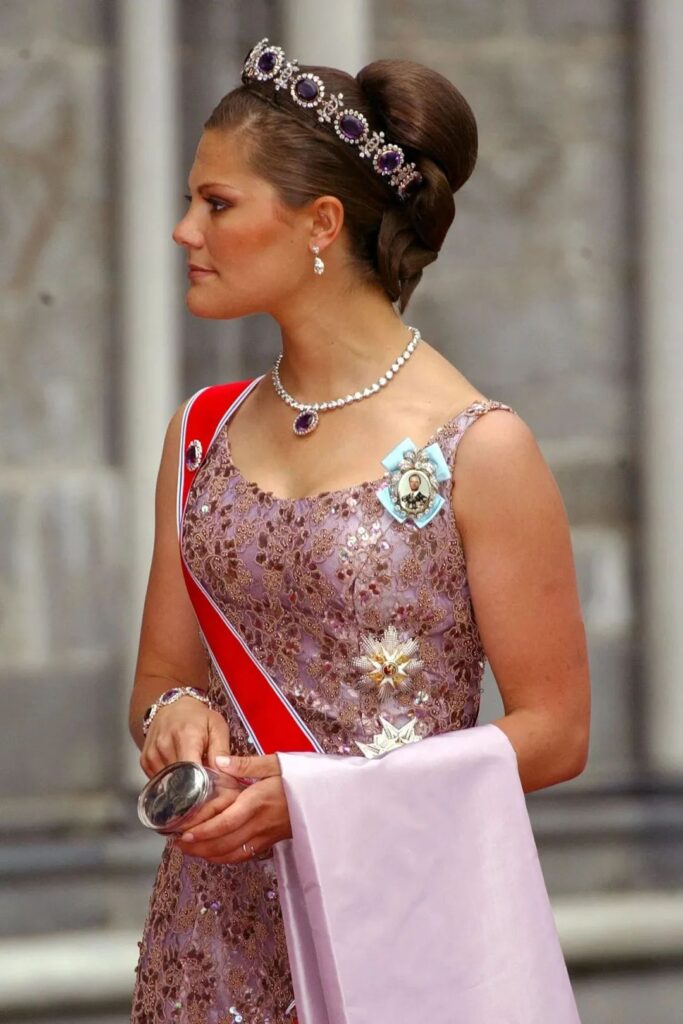
Amethyst may not be the most eye-catching in terms of “value” in the high jewelry circle, but it truly has a more “dramatic life” than any other gemstone.
It reached its peak at its debut, becoming royalty’s favorite, then fell out of favor and was demoted. It turned around to become a “people’s icon,” but then became an “outdated idol” due to unfortunate timing. Now, it has returned to its peak, once again favored by the high jewelry circle! Can you guess what its roller-coaster “comeback story” relied on?
Humans discovered the beauty of amethyst very early on. Its unique purple hue made it a hundred times more valuable, and only those at the top of royal power had the right to use this gemstone symbolizing royal authority.
The ancient Greeks believed it was a gift from the god of wine, and wearing amethyst could prevent drunkenness. The ancient Romans considered purple a symbol of imperial reverence, and Cleopatra wore an amethyst ring throughout her relationships with Julius Caesar and Mark Antony.
Even the Catholic Church believed that amethyst represented piety and chastity, so bishops’ rings often featured amethyst as the main stone. Therefore, it’s not surprising that many crosses are inlaid with amethyst.
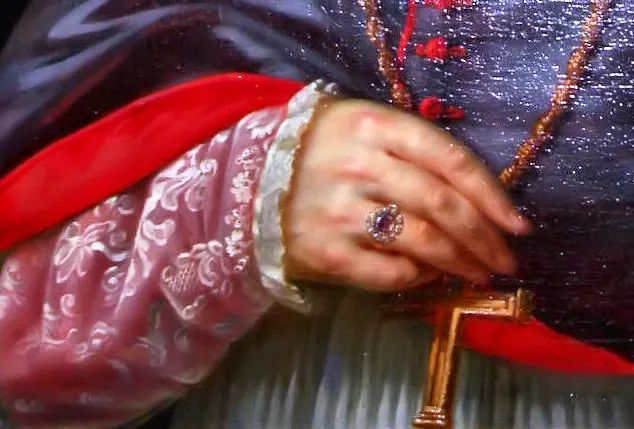
Before the 19th century, amethyst was very scarce, making it exclusive to royalty and nobility. For a long time, it was as valuable as sapphires, rubies, and emeralds, so amethyst can often be seen in royal jewelry collections.
French Empress Josephine led the revival of the Empire style, and jewelry naturally had to follow the aesthetics of ancient Greece and Rome. Cameo gemstones and amethyst were perfect choices. She once created an entire set of amethyst jewelry, known as the “Napoleon Amethyst Parure.”
It was later given as a wedding gift to her daughter-in-law, Princess Augusta of Bavaria, and then entered the Swedish royal family as part of the dowry of her daughter, Princess Josephine (Queen of Oscar I of Sweden).


The original version of the “Napoleon Amethyst Parure” was a Demi-Parure without a tiara. The current Queen Silvia of Sweden transformed the necklace into a tiara and the bracelet into a necklace. Note that they can still be worn in their original style, essentially adding more flexible wearing options.
As a result, this set of jewelry has become an extremely popular royal jewel, with many princesses borrowing and interpreting their own amethyst style in different ways.
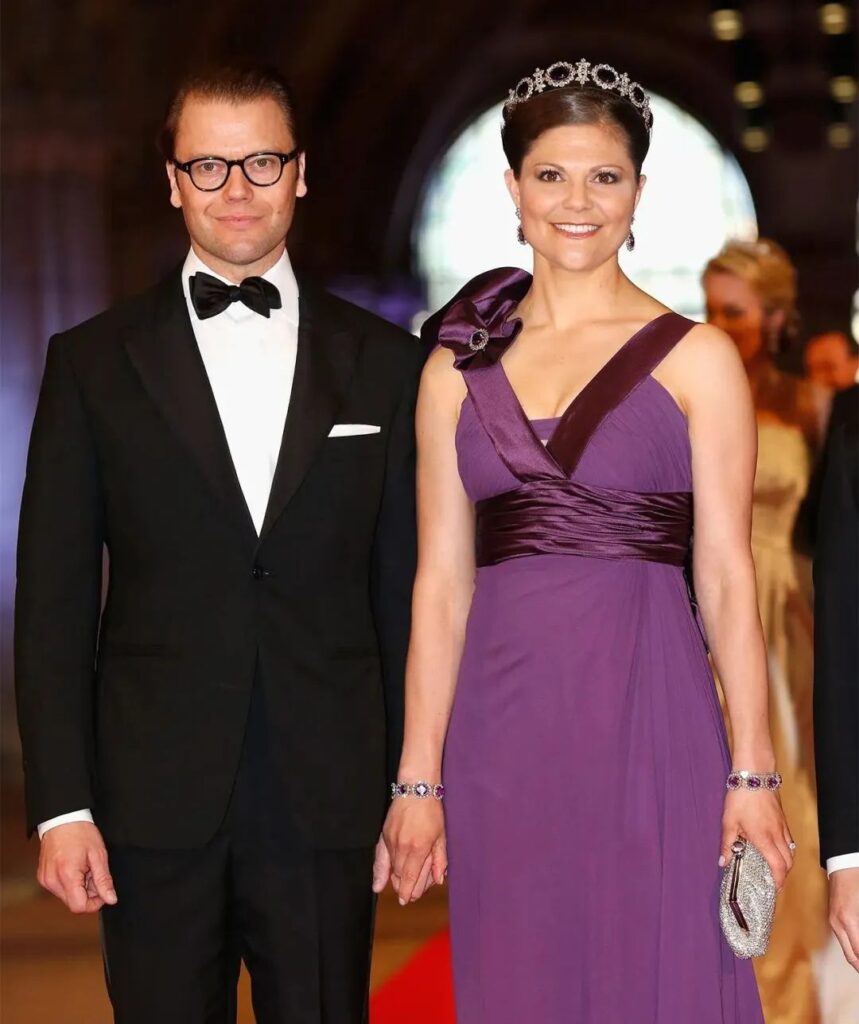

The most valuable amethyst jewelry in the British royal collection comes from the parure of Queen Victoria’s mother, the Duchess of Kent. This Demi-Parure, without a tiara, features very large amethysts and is more opulent than Josephine’s set. The Duchess later bequeathed this set to Queen Victoria. At that time, amethysts were still very rare, and the Queen specifically designated it as a royal “heirloom.”
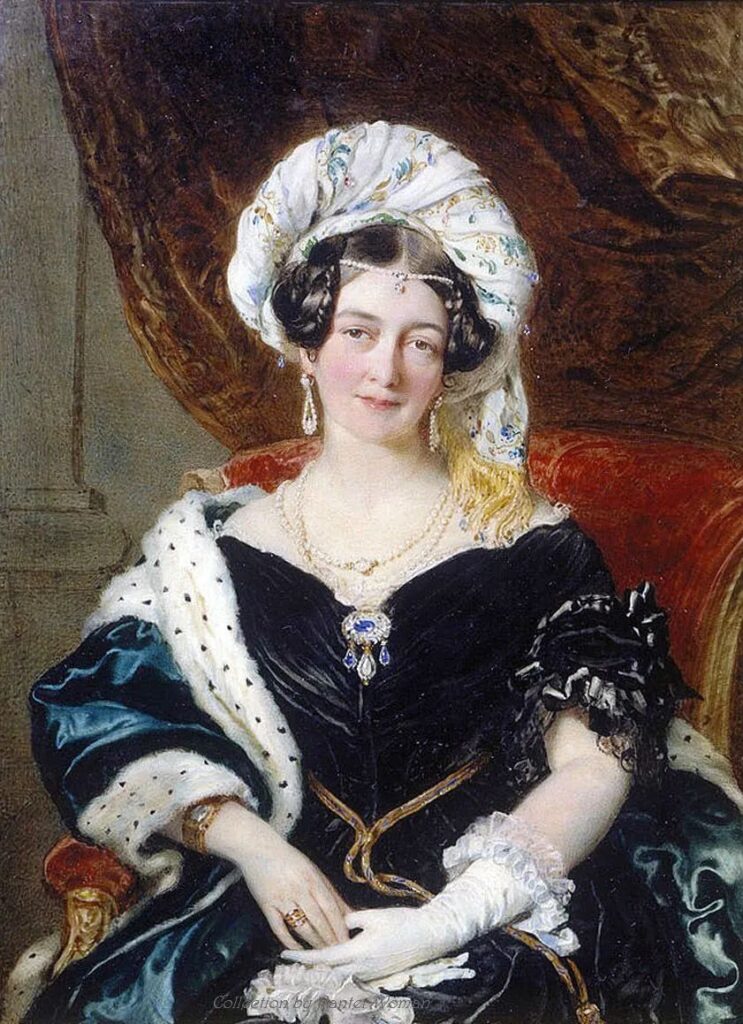
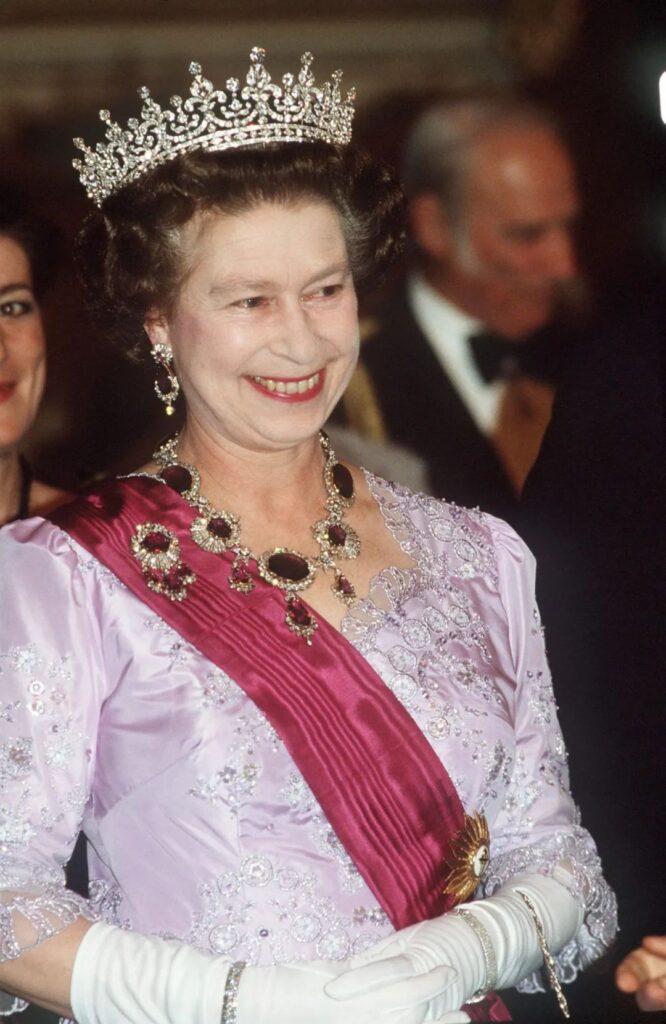
This amethyst set includes a necklace, a pair of hair combs, a pair of earrings, and three brooches. However, Queen Elizabeth II rarely wore the full set, more often opting for various versions of the brooches.

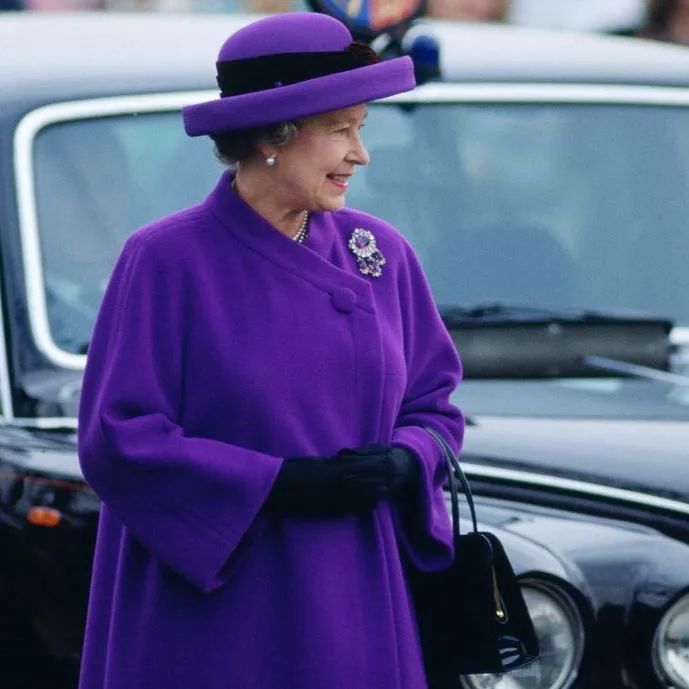
In Eastern Europe, Russian Empress Catherine the Great also loved amethysts, often sending expeditions to the Ural Mountains to find her beloved purple gemstones. Examples include the amethyst and diamond Girandole earrings that appeared in a Christie’s auction, as well as an amethyst ring engraved with her portrait.
However, as you know, the collapse of the Romanov dynasty scattered the royal jewelry collection, with many pieces lost to history.
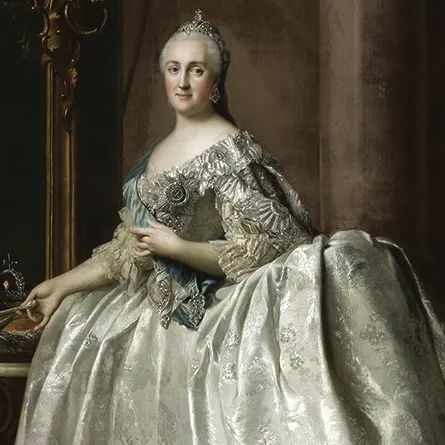
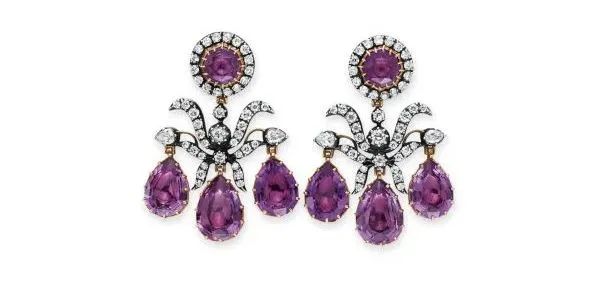

In the 19th century, the discovery of amethyst mines in South America flooded the market with large quantities of amethysts, causing their value to plummet. They were no longer considered rare gemstones.
This was undoubtedly the first turning point in amethyst’s fate. However, it was fortunate to coincide with the peak of jewelry development during the Victorian era when jewelry was no longer exclusive to nobility and royalty. More people could afford to wear jewelry, and the entire jewelry industry experienced rapid growth.
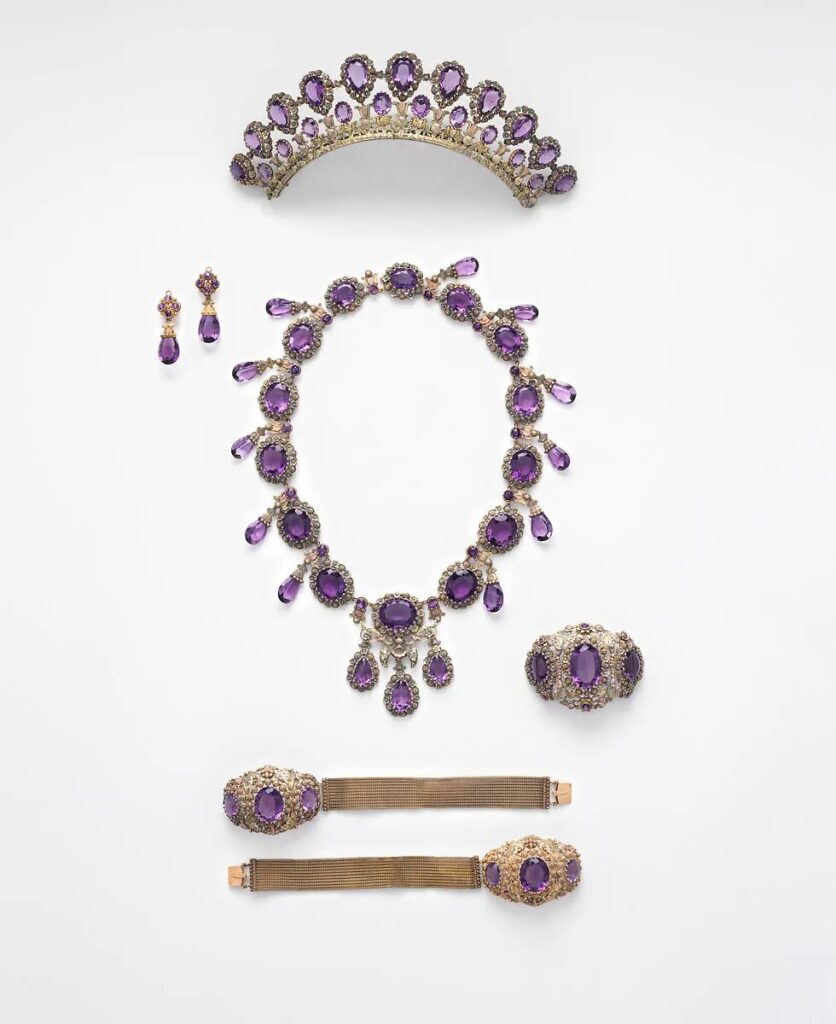
Currently in the Metropolitan Museum of Art, New York
Amethysts, with their unique color and large carat advantage, became an excellent choice among semi-precious stones. They remained popular from the Victorian era through the Neoclassical period. Their mysterious, subdued color and large carat settings perfectly complemented the fashionable large crinoline silhouettes of the time. Only amethysts could display luxurious splendor while maintaining restraint and elegance.
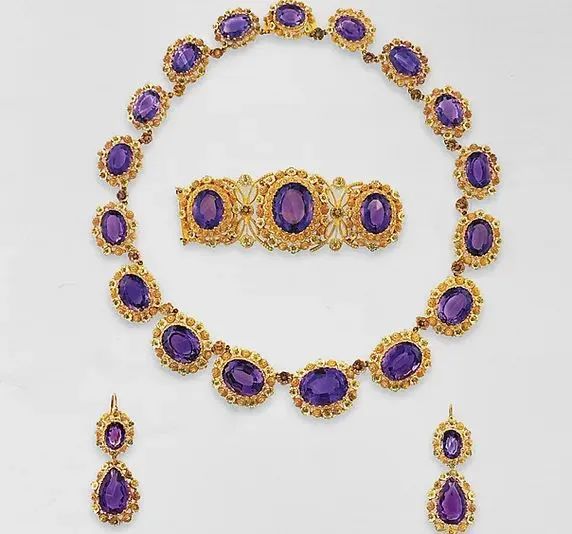
Whether in balanced wreath-like designs or intricate pendant designs, the purple gemstone could hold its own. Therefore, although its price decreased and it became less rare, large carat, high clarity amethysts were still favored by royalty, who needed glamorous jewelry for formal occasions more than anyone else.

Queen Alexandra was particularly fond of amethysts and collected numerous amethyst jewels. She left the huge amethyst tiara and wreath necklace to her granddaughter, Princess Maud, Countess of Southesk. Her successor sent it to Sotheby’s for auction in 1946. Since then, the tiara has not been seen in public, but the amethyst wreath necklace reappeared at Sotheby’s in 2007, selling for $115,000.
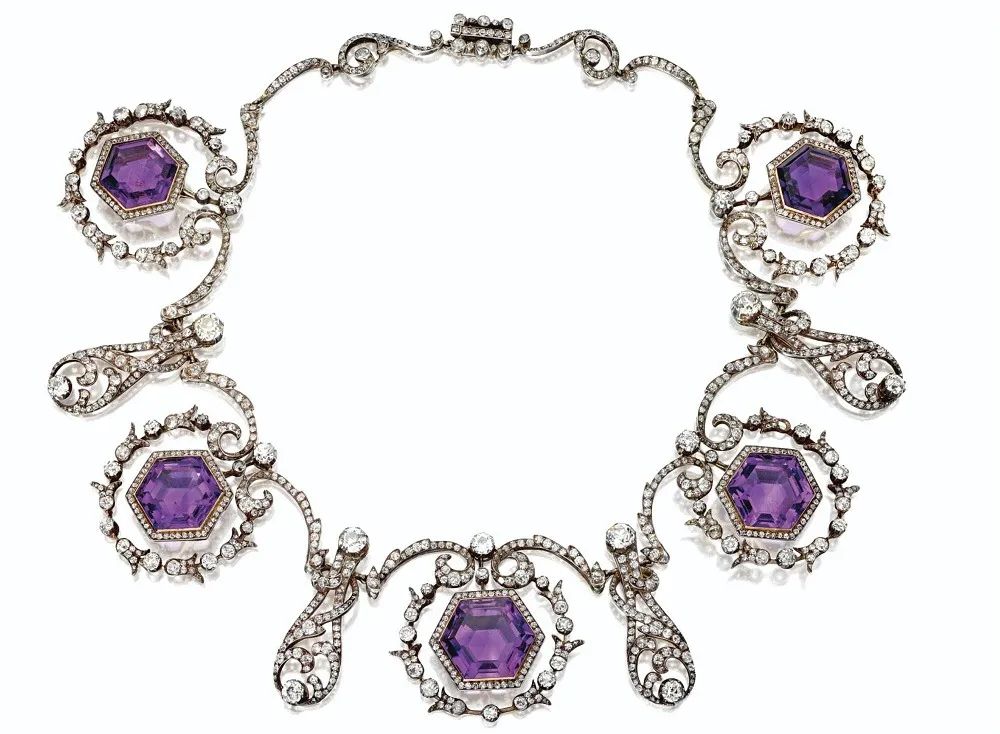
Possibly due to the value of amethysts, jewelry from this period focused more on design and style, primarily satisfying fashion and accessorizing needs. As a result, most pieces were not designated as “heirlooms,” and many left royal collections, appearing in auctions.
In addition to Queen Alexandra’s amethyst set entering auctions, Queen Mary’s amethyst parure later appeared at auction houses as well. As a “jewelry enthusiast” and trendsetter, she had to follow this fashion, creating an amethyst tiara and matching necklace.
However, their whereabouts were unknown until they appeared at Sotheby’s auction in 1993. The auction house revealed that the seller was not a member of the royal family, indicating that she had given this set to friends or relatives outside the royal circle.
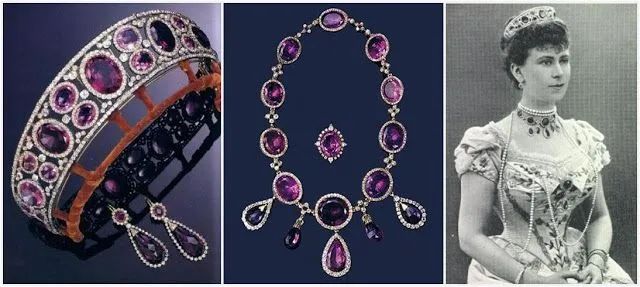
From another perspective, amethyst jewelry from this period was exquisitely crafted, often appearing in sets, and demonstrated high standards in material selection, setting, and metalwork. Most importantly, amethyst was trendy at the time, so there were many choices. If any readers are interested in acquiring antique jewelry, amethyst pieces are definitely worth considering.
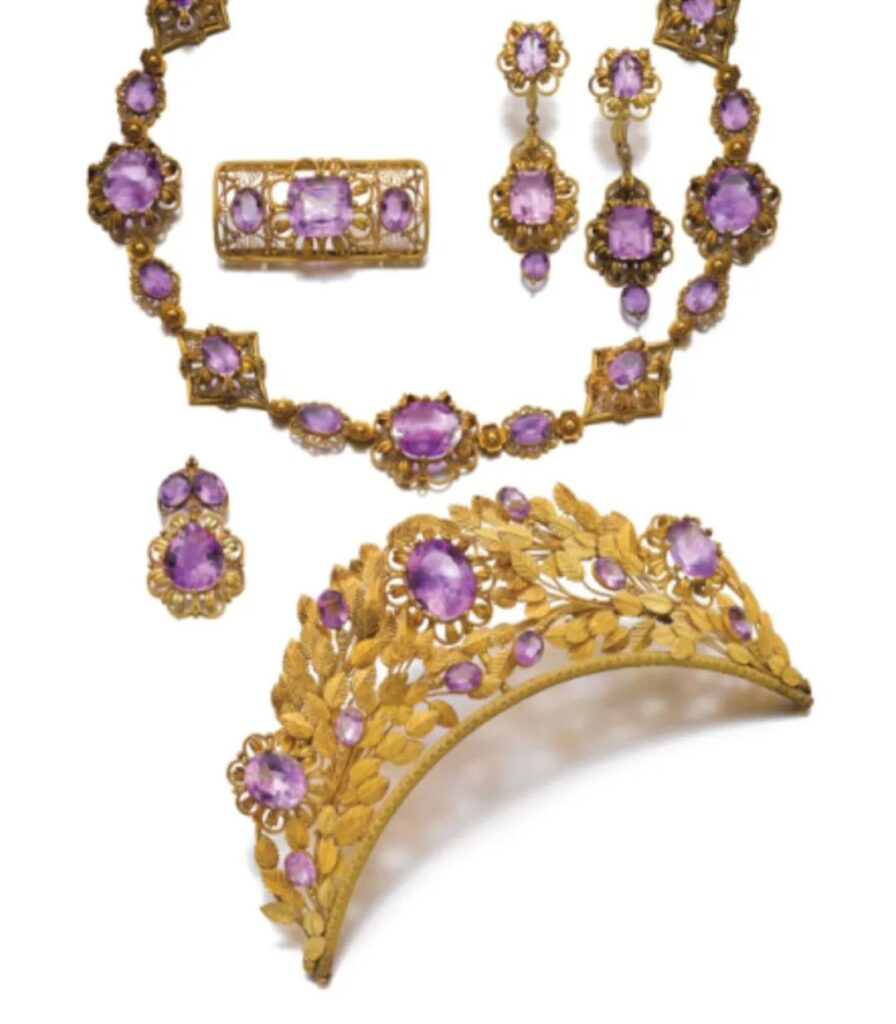
At the end of the 19th and beginning of the 20th century, the large skirts of the Neoclassical period gradually fell out of fashion, and delicate jewelry styles began to gain popularity. The invention of electric lights and the discovery of South African diamond mines ushered the jewelry world into a “white era.” Amethyst, along with many other colorful semi-precious stones, was gradually forgotten as dazzling diamonds took center stage in the jewelry world.
However, war changed everything. First, South African diamonds couldn’t be transported to Europe during the war, and then platinum, its “best partner,” was requisitioned as a military resource. After the war, people longed to return to a happier and more glamorous era. Amethyst’s vibrant color and abundant supply became advantages in reclaiming the spotlight, allowing it to successfully “make a comeback.”

Major jewelry brands demonstrated excellent adaptability during this period. Glamorous sets no longer matched modern attire, and exaggerated single pieces of jewelry became the mainstream choice for more people. How to make a piece of jewelry the finishing touch of an entire look? Through contrasting color designs that complement each other, of course.
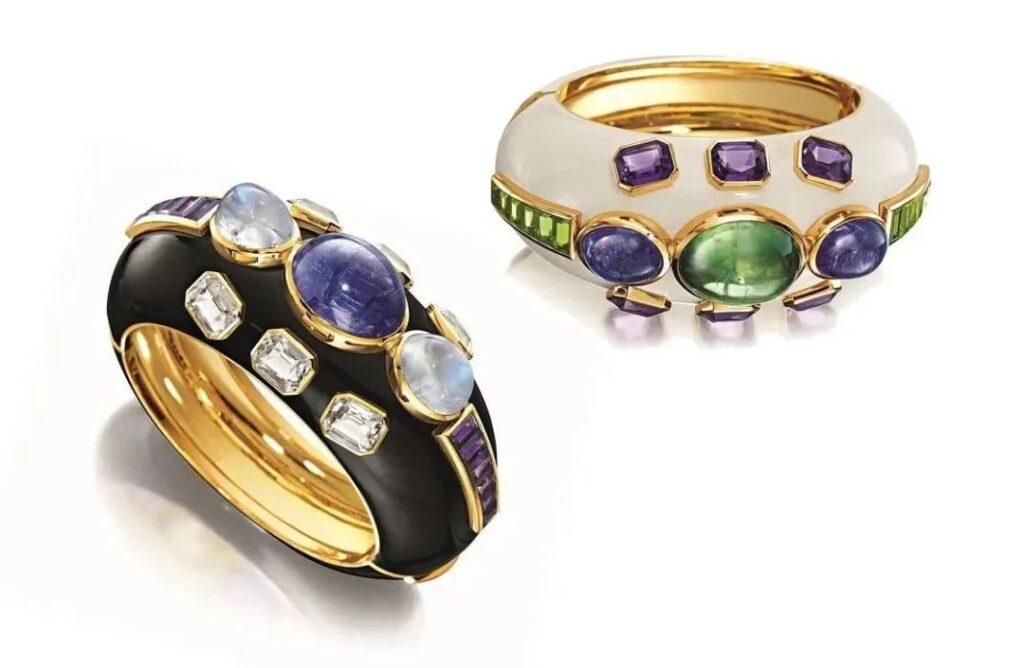
Cartier achieved ultimate brilliance in the 1950s by combining faceted amethysts with turquoise. The vibrant, high-chroma turquoise created a stunning contrast with the deep, romantic amethyst.
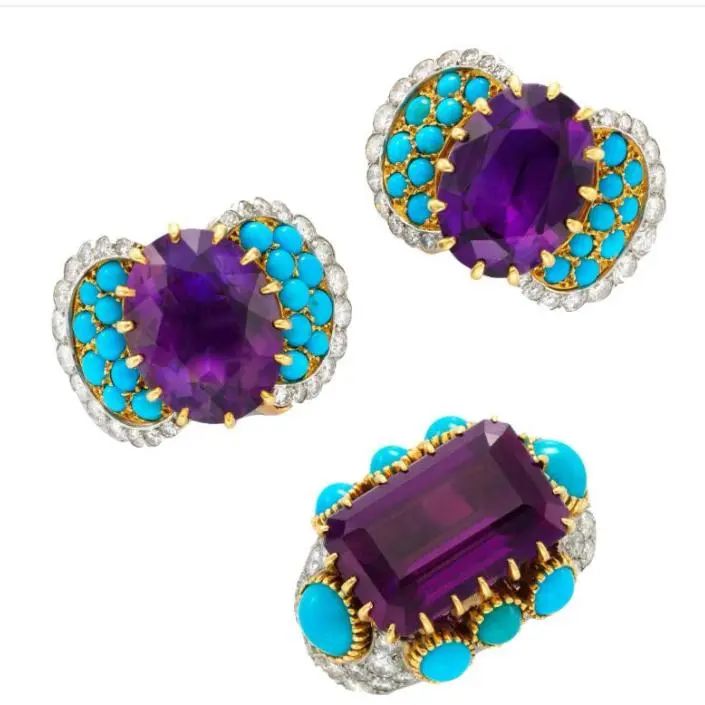
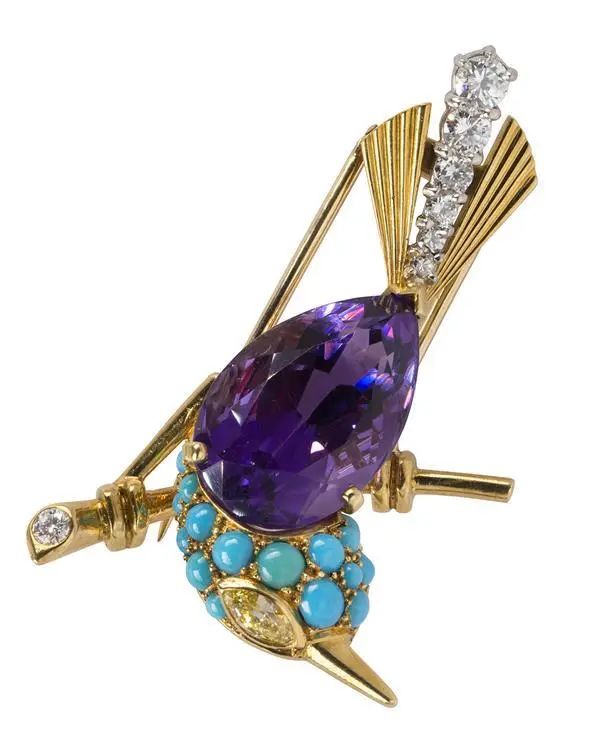
Gold, amethyst, turquoise, diamonds
Van Cleef & Arpels accurately captured the hippie trend in the 1970s, preferring to cut amethysts into beads and pair them with warm coral or brilliant gold to balance the cool and warm tones of their pieces.
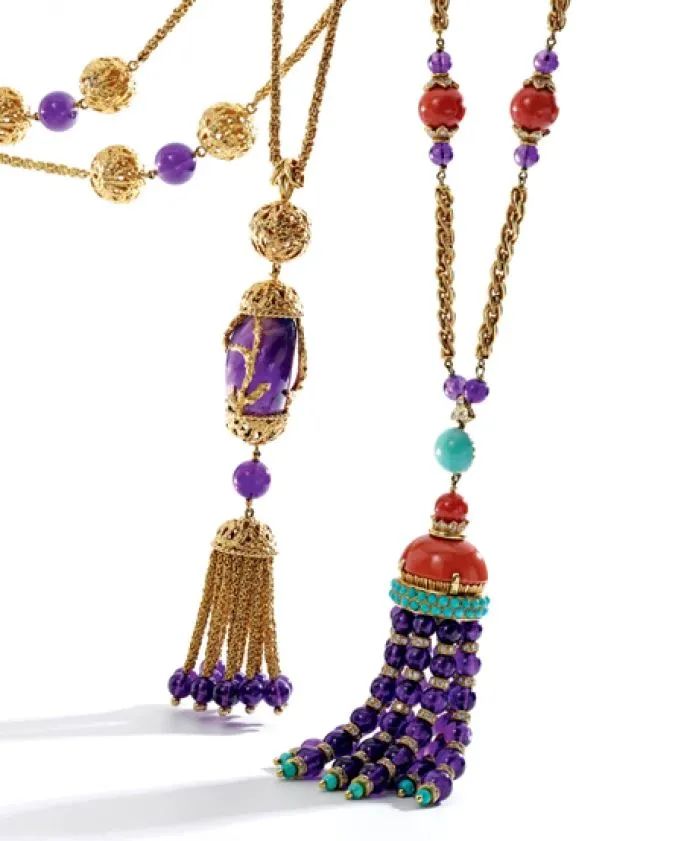
Gold, amethyst, turquoise, coral, diamonds
American jewelry designer David Webb was even bolder, favoring extreme contrasts—the collision of purple and green. Amethyst naturally played the lead role and could be presented in any form: faceted, beaded, or carved. The green choices were diverse, with malachite, emerald, and enamel all complementing the romantic purple, creating a powerful visual impact when combined.
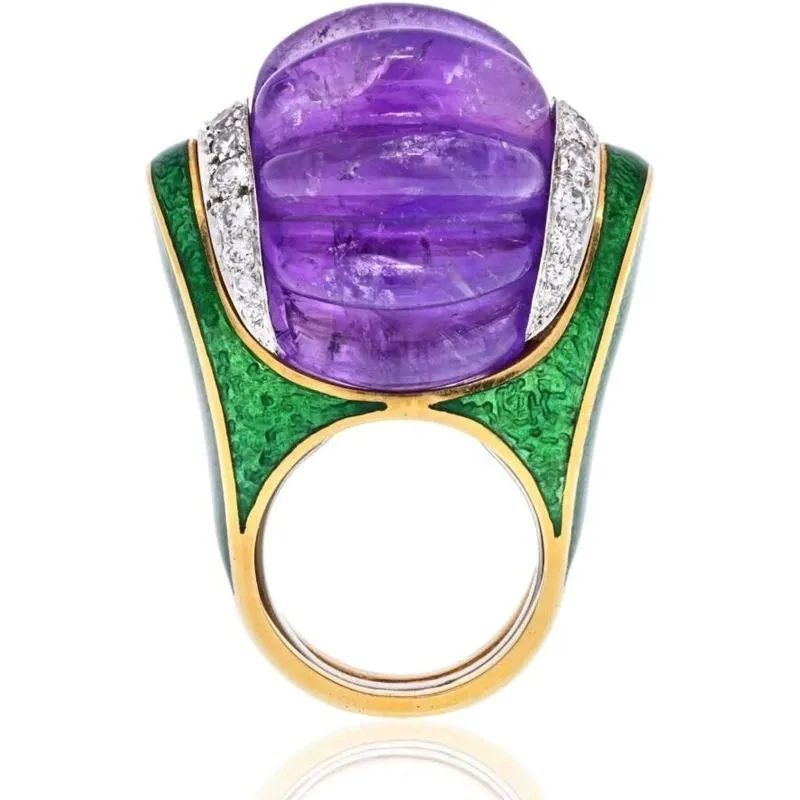
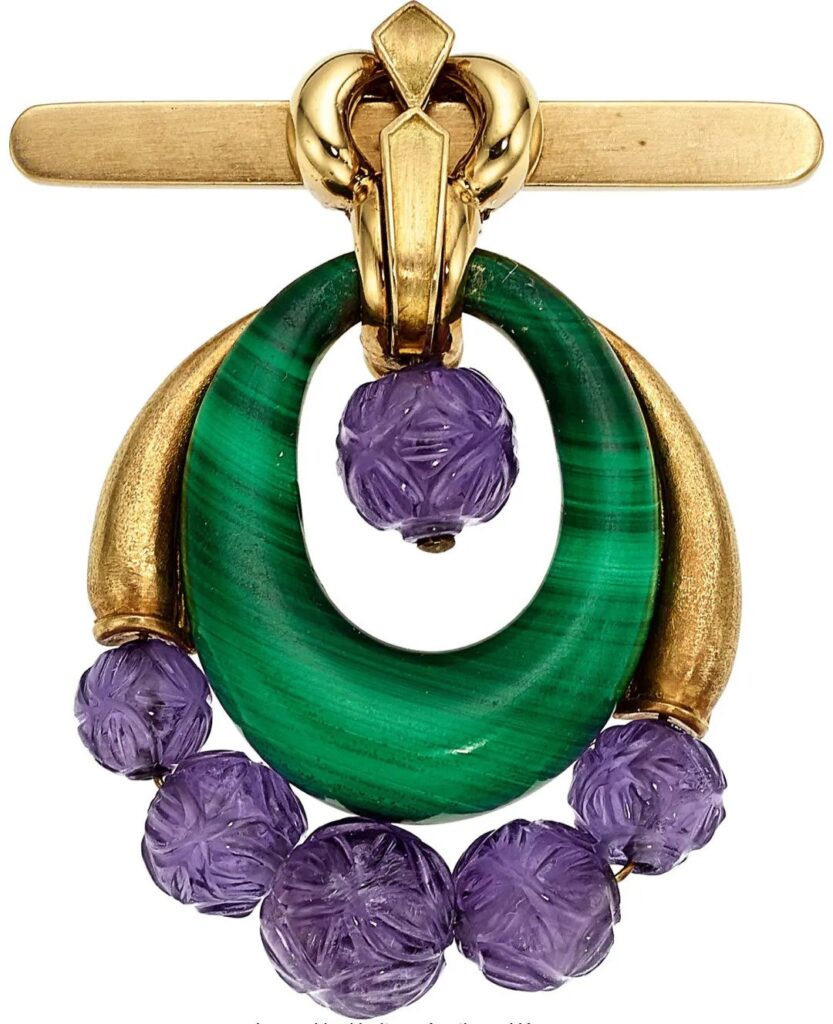
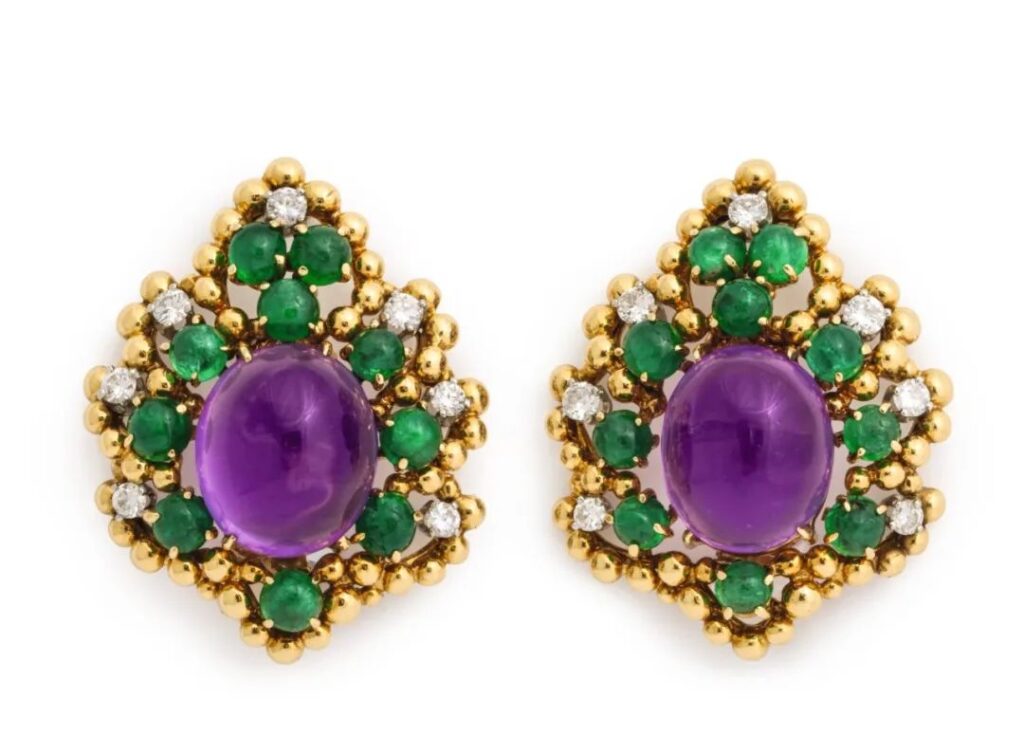
Upon careful observation of amethyst’s rich purple hue and transparent interior, it’s not difficult to understand why it was the darling of various jewelry icons in the past.
If you think about it, truly purple gemstones are rare in nature: purple sapphires often have a color shift, appearing more violet; chalcedony lacks clarity; and kunzite, despite having “purple” in its Chinese name, is more of a pink gemstone.
Therefore, the pure purple of amethyst is almost irreplaceable in the jewelry world. Even though amethyst is not as rare, it remains an indispensable and important player in high jewelry.
Cocktail Rings: Mastering the Delicate Balance Between Sobriety and Tipsiness
Cocktail rings emerged in the 1920s, yes, during the era of Prohibition in the United States, and also a time of significant progress for feminism. Thus, their appearance symbolized “rebellion,” with wearing eye-catching, exaggerated rings marking the new woman’s resistance to traditional constraints.
These fashionable women would actively appear at various gatherings, perhaps balancing between sobriety and tipsiness, but they would say: “I wear earrings and necklaces for others to admire, but I wear cocktail rings for myself.”

Amethyst, turquoise
In modern times, cocktail rings are more often worn as “statement jewelry,” with the primary task of drawing attention. Amethyst’s unique color and large carat advantage naturally allow it to play the leading role, easily mastering both vintage and modern styles.
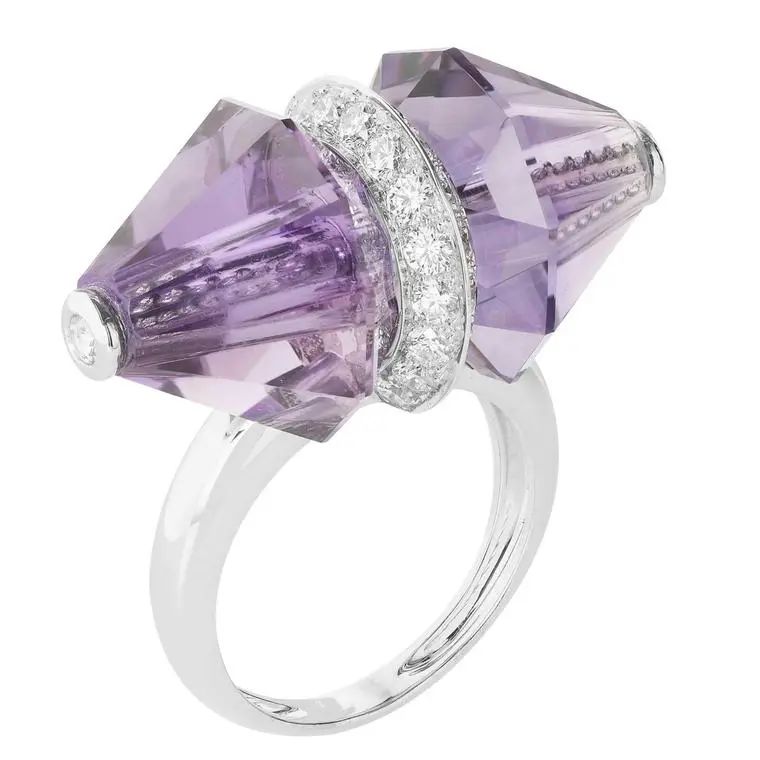
Ispahan Amethyst Ring
Elizabeth Gage designed a cocktail ring featuring a 44.58-carat untreated Brazilian amethyst carved by master craftsman Michael Dyber, showcasing artistry.

Kara Ross’s Petra High Jewelry Collection ring uses the stark contrast between raw and cut gemstones to display the collision between nature and industrial society. Of course, amethyst’s crystal form is indeed worth appreciating.
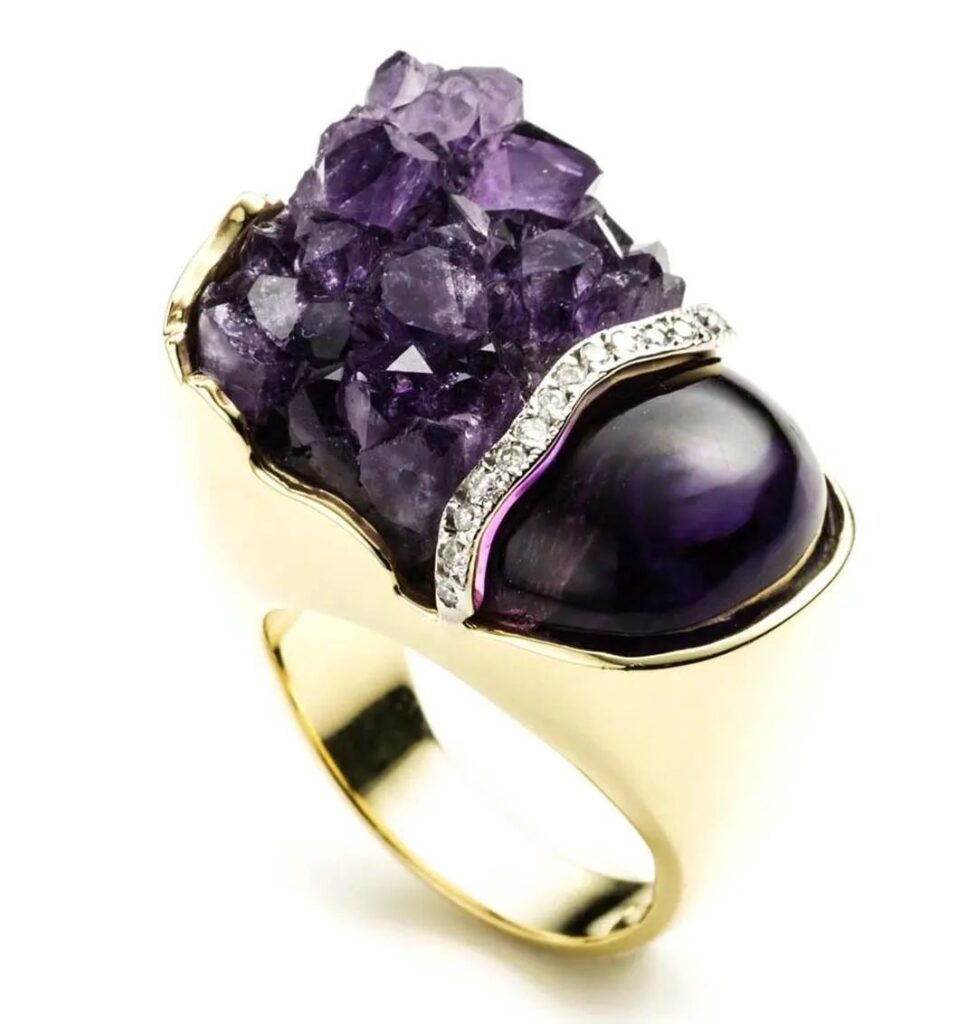
Emily H London’s Emilia ring emphasizes the mysterious color of amethyst. The cabochon cut is an excellent choice to showcase the deep purple hue, further accentuated by the high fire of sapphires and yellow diamonds, highlighting the ultimate purple of amethyst.
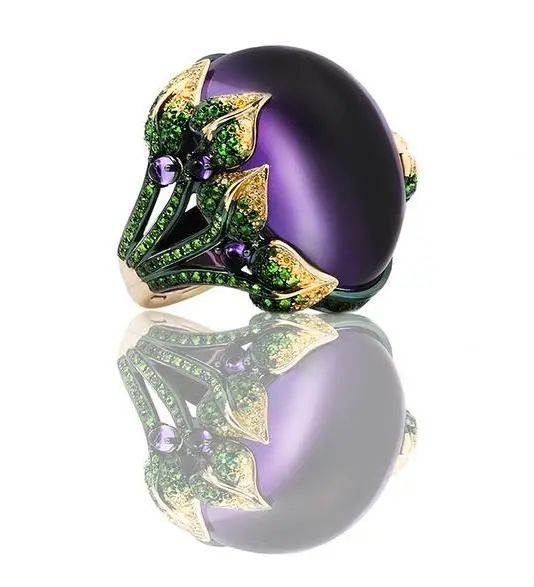
Amethyst, sapphire, yellow diamonds
Alexandra Mor’s cocktail ring showcases an architectural style, with a 68-carat step-cut Zambian amethyst set in a minimalist platinum and diamond design. The concise layers and structural beauty evoke a sense of calm, highlighting a rational aesthetic.
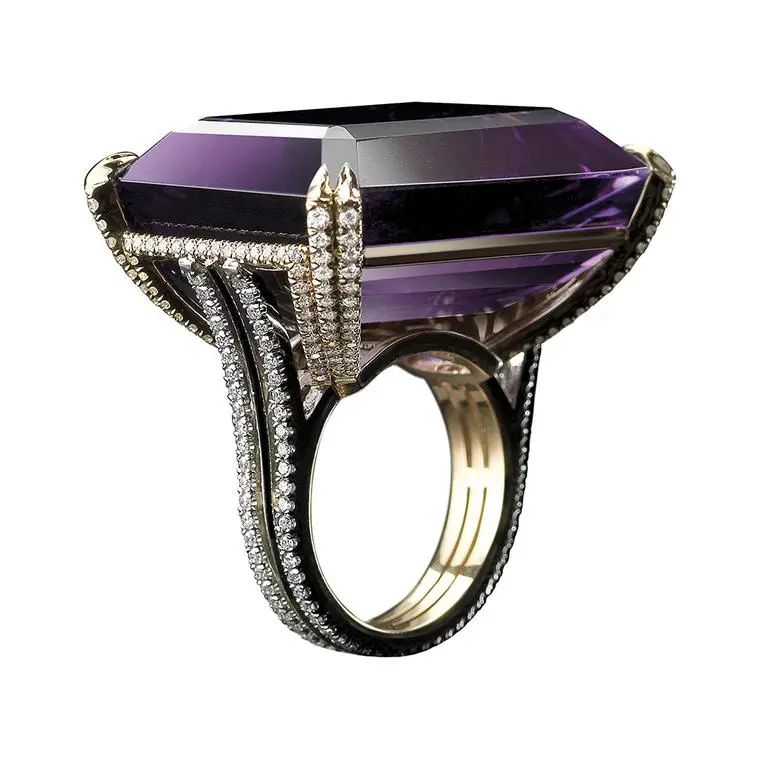
18K yellow gold, amethyst, diamonds
Mysterious Charm on Bracelets: The Spotlight for Carved Amethysts
Due to amethyst’s large carat characteristics, it’s an excellent choice for carved gemstones. Apart from basic beads, many independent designers like to use carved amethysts to write their “signature style,” especially on bracelets and cuffs, making them the main stage for carved amethyst beauty contests.
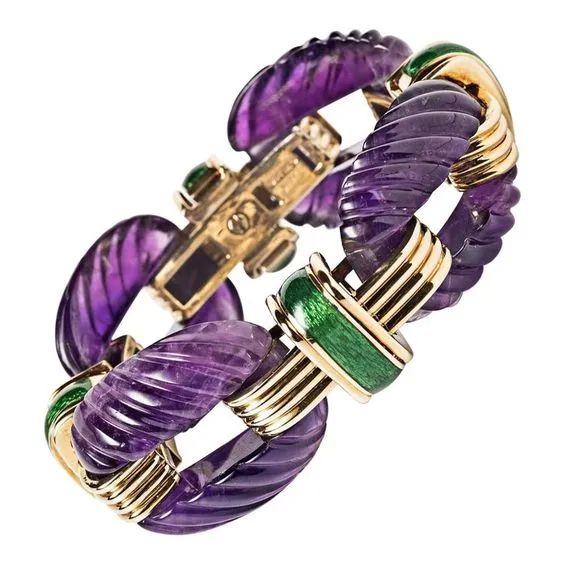
David Webb often produces amethyst carved bracelets. In addition to his signature twisted carving, he also chooses semi-transparent amethysts with natural patterns to carve more figurative images, such as the seahorse bracelet.
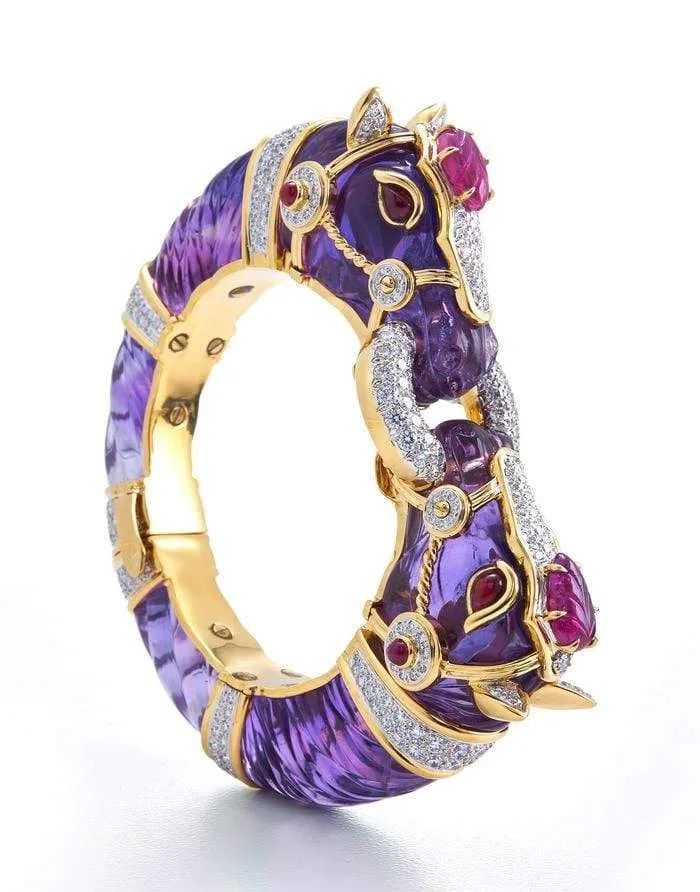
Amethyst, ruby, diamonds
Another designer who loves amethyst, chalcedony, and other translucent materials, Suzanne Belperron, likes to use amethyst in large areas, turning it into a sculptural art piece, achieving an absolutely unique level.
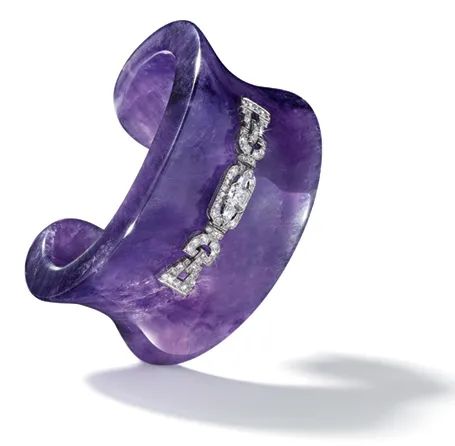
There are also designers who prefer natural-form carving, like Van Cleef & Arpels and Verdura, solely to emphasize the natural feel. This way, each amethyst is unique, and when worn on the wrist, it exudes a beauty of returning to nature.
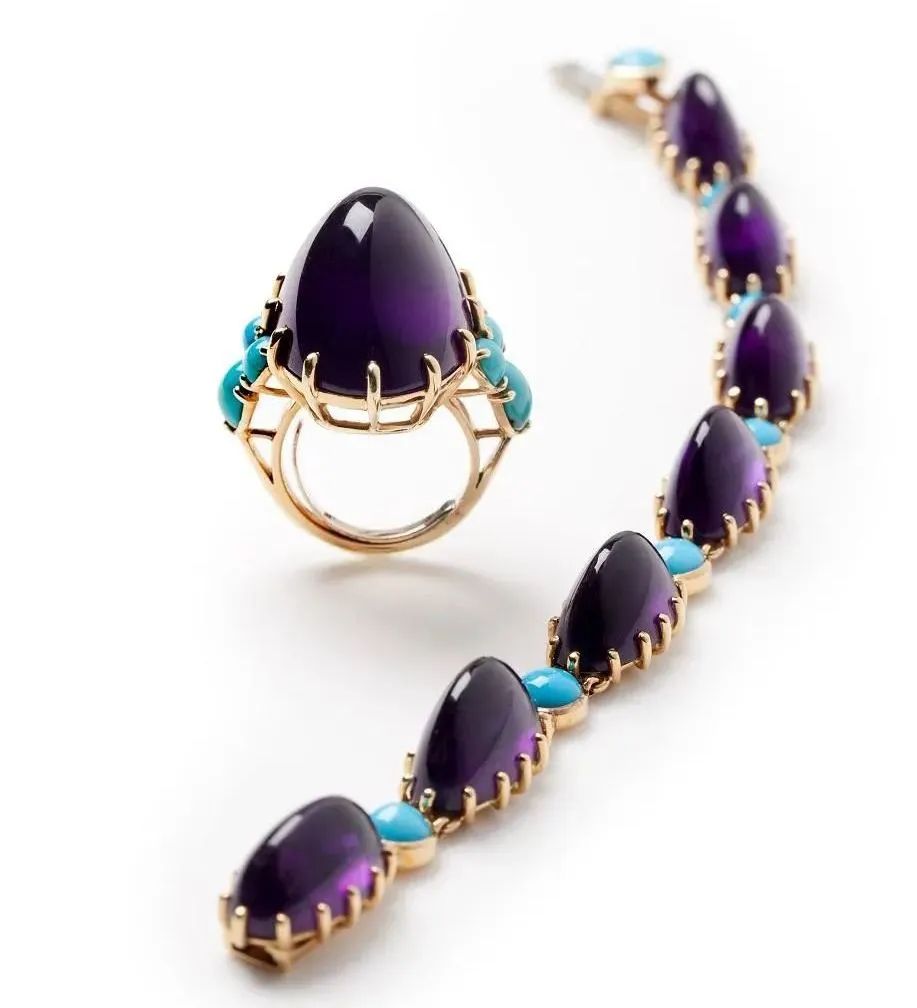
Amethyst, turquoise
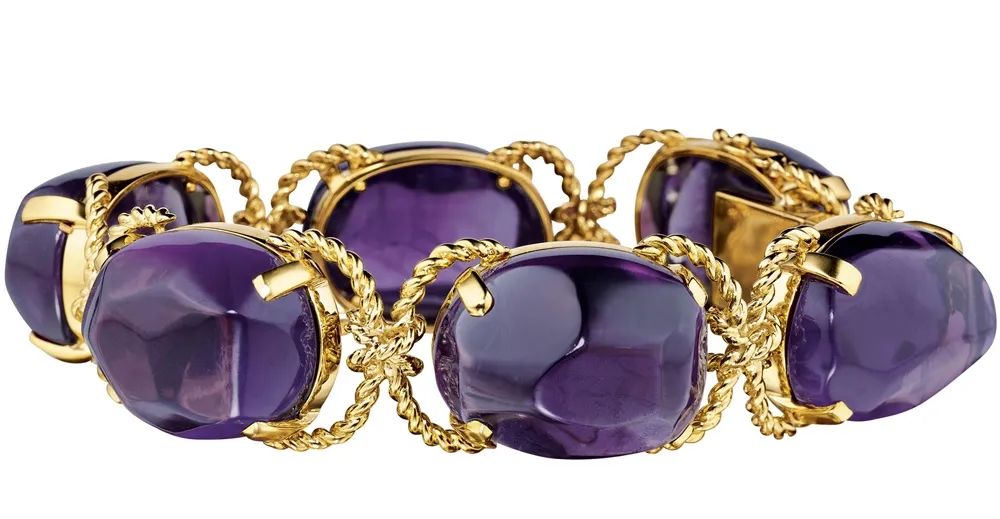
18K yellow gold, amethyst
Amethysts at the Ears: Swaying Romance
When amethysts are used in earrings, they are mostly in long, dangling designs because only this tassel-like swaying can highlight their romance. However, jewelry brands have their own ways of making them sway. Bulgari uses a beaded form, creating a color collision with emerald beads, making it more lively and bouncy.
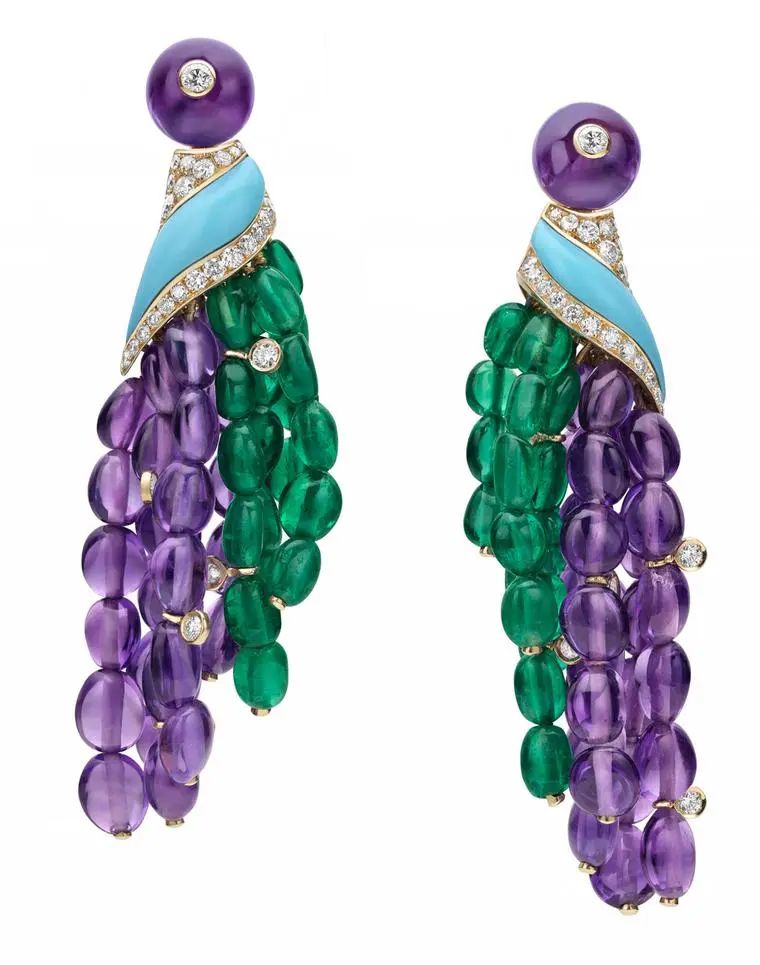
de GRISOGONO aims to showcase the crystal-clear quality of amethyst, with teardrop-shaped amethysts gathering and dropping down to make the purple color appear luscious and alluring.

Amethyst, ruby, emerald
Barbara Bixby’s butterfly earrings in the Zen Garden series, made with amethyst and dark-toned gemstones, display the tranquil quality of amethyst. The moment the butterfly lightly lands should be full of zen-like quietude.
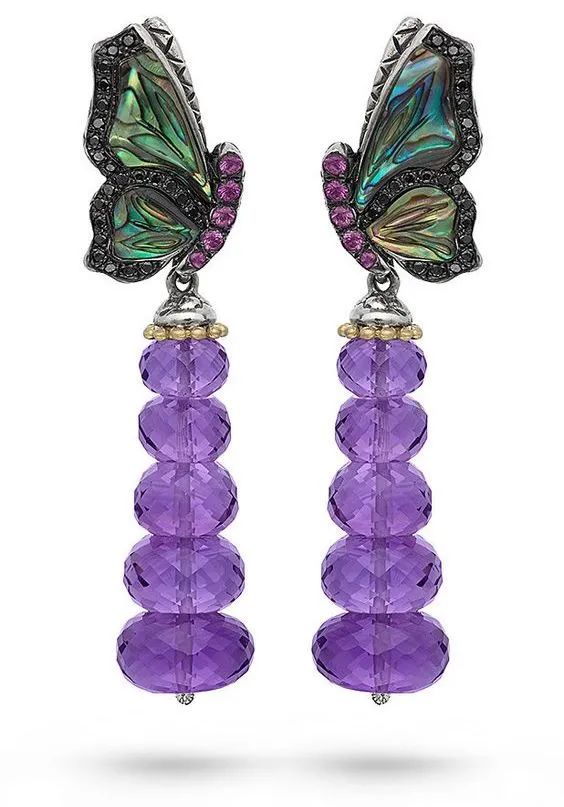
Amethyst, black diamonds, black mother-of-pearl, sapphire, diamonds
Amethyst Necklaces: Flaunting Unique Colors
When creating necklaces with amethyst, the focus is on showcasing its unique color.
For example, Bulgari, skilled in using colors, always includes multi-gemstone necklaces in each season’s high jewelry collection to highlight the brand’s DNA. You’ll notice that to display this Italian joyful color palette, there must be at least five colors, and amethyst always has a place because it’s the irreplaceable purple gemstone choice.
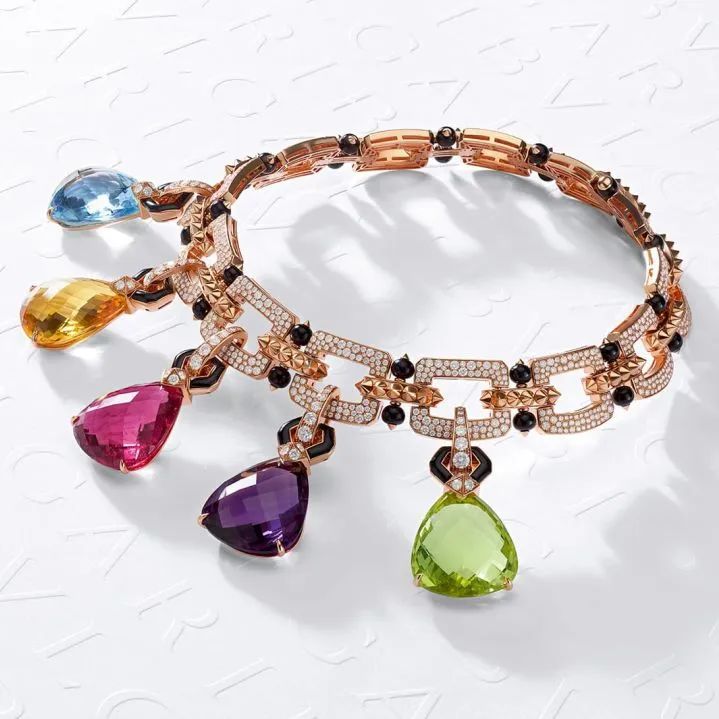
Hidden Treasures Necklace
18K rose gold, tourmaline, amethyst, garnet, aquamarine, citrine, agate, diamonds
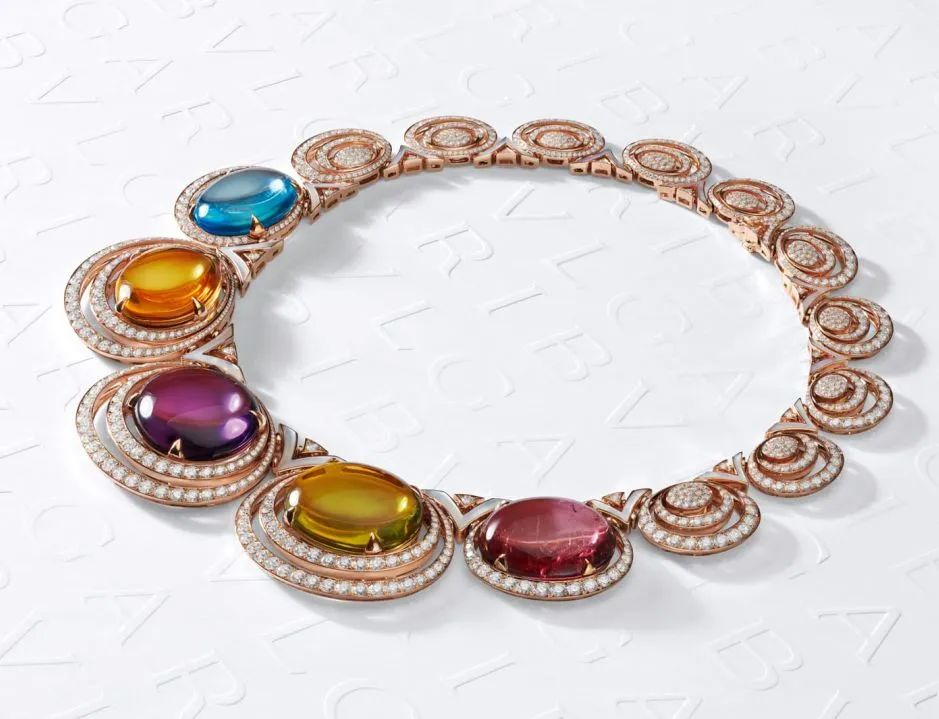
Color Ripple Necklace
18K rose gold, tourmaline, topaz, citrine, amethyst, diamonds
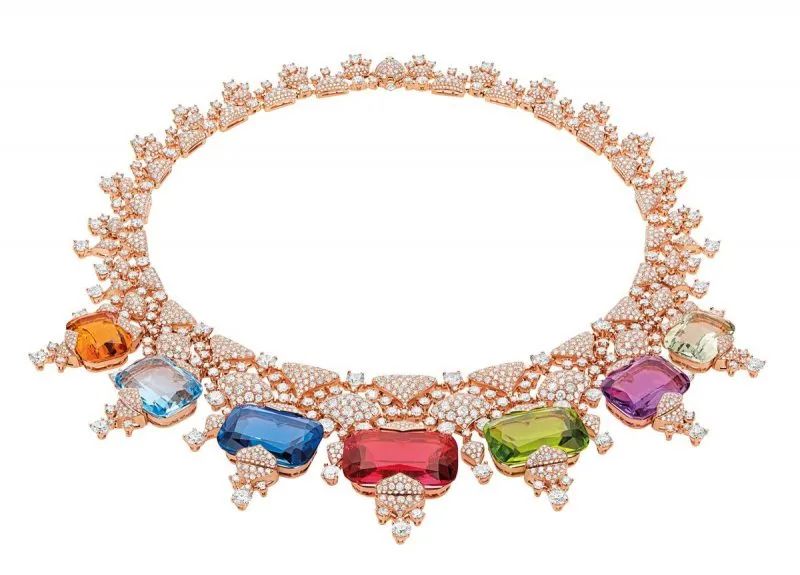
Juicy Exuberance Necklace
18K rose gold, citrine, aquamarine, topaz, tourmaline, amethyst, peridot, green quartz, diamonds
Of course, some brands pursue only the display of ultimate purple. Even with its high production, amethysts have their highs and lows, and rich, high-clarity amethysts still belong to the rare gemstone category.
For instance, Van Cleef & Arpels’ “Secret de Cassis” necklace uses beads cut from the same amethyst, paired with sapphires and agate, showcasing rich purple in gradient details, accented with diamonds. The mature sweetness of blackcurrant is palpable.
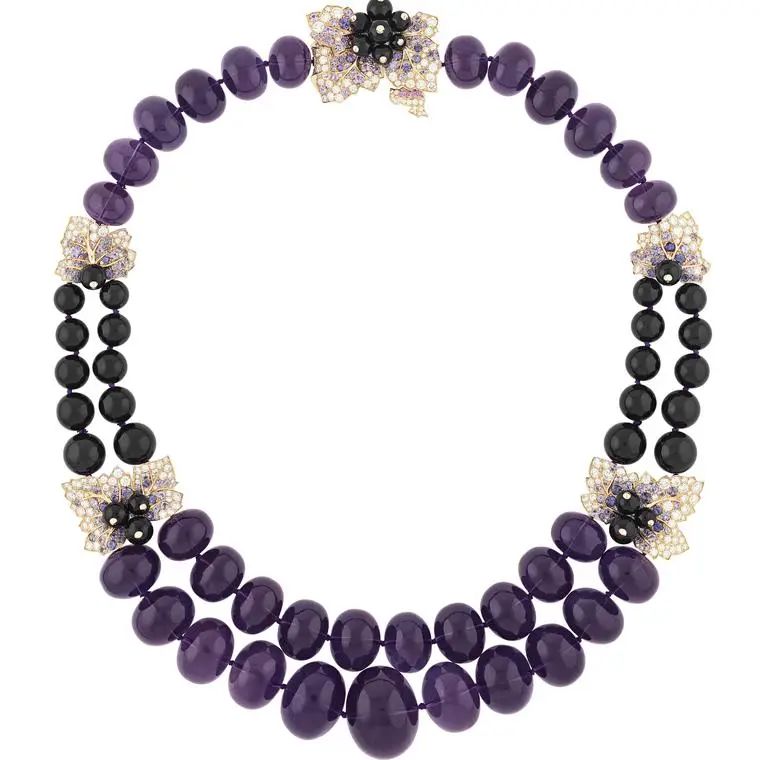
Amethyst, agate, sapphire, diamonds
When you see Cartier’s amethyst panther series necklace, it’s impossible to ignore the 174.52-carat amethyst! Perhaps in this piece, the panther is responsible for lazily showcasing craftsmanship and style, while the amethyst is responsible for displaying the charm of the gemstone.
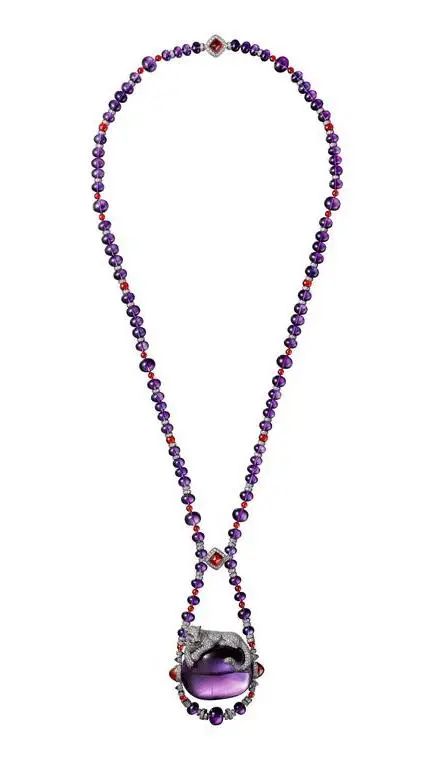
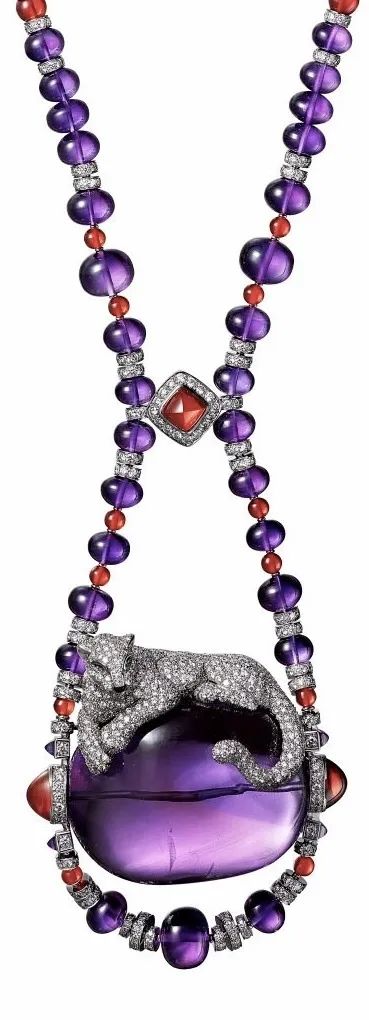
White gold, amethyst, ruby, diamonds
So, isn’t amethyst a “high value for money” gemstone? It absolutely achieves a level of versatility that allows you to realize your collection freedom.
The editor strongly recommends vintage pieces. Although they may seem overly complex, most can be disassembled. Learn from the Queen of Sweden, flexibly recombine them, and you deserve to own this jewelry with exquisite craftsmanship and solid materials!
The Royal Comeback: How Amethyst Reclaimed Its Crown in High Jewelry
Tweet
